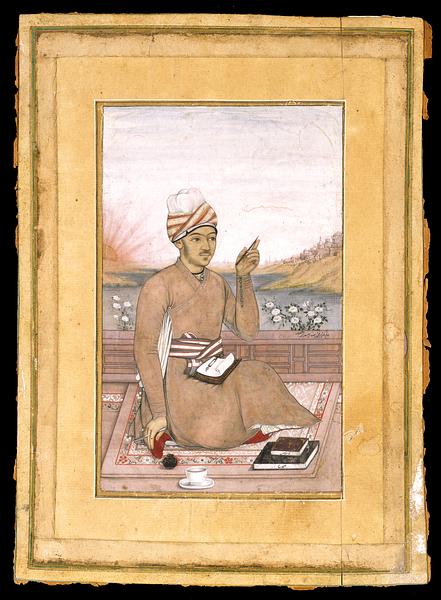Miniature pasted on an album leaf. ‘A Scribe on a Terrace’
Iran; 1169 H = 1755
Miniature: 18.8 × 11.8 cm
Muhammad Riza-i Hindi – who came from India, as his name indicates – painted, signed, and dated this finely modeled portrait of a young calligrapher, whose identity is unknown. He is seated on a cushion placed on a carpet-covered terrace, in a characteristic scribe’s position, without a table. Instead, he has a writing pad on his lap holding a piece of paper and a makta, a pen rest used in cutting pens. In his right hand he holds his penknife and in his left the newly cut pen, whose point he seems to be inspecting. In front of him are his spherical inkwell, a cup and saucer, and a couple of Arabic dictionaries, whose titles are written on the edge.
Inv. no. 15/2002
Published in:
Sotheby’s, London, 25/4-2002, lot 43;
Kjeld von Folsach: For the Privileged Few: Islamic Miniatures from the David Collection, Louisiana, Humlebæk 2007, cat.no. 96;
Kjeld von Folsach, Joachim Meyer: The Human Figure in Islamic Art – Holy Men, Princes, and Commoners, The David Collection, Copenhagen 2017, fig. 55, p. 238;
Angelika Neuwirth: “The 'Discovery of writing' in the Qur'an : tracing a cultural shift in Arab late antiquity” in Nuha Alshaar (ed.): The Qur’an and adab : the shaping of literary traditions in classical Islam, Oxford 2017, p. 19;
Marcus Fraser: “Muhammad Riza-I Hindi. An important Indo-Persian artist of the mid-eighteenth century” in Journal of the David Collection, 2021, 5, fig.8, cat.no. 7, pp. 193-195;
Willem Floor and Amélie Couvrat Desvergnes: History of paper in Iran 1501-1925, Washington 2022, pp. 40-41, fig. 17;
Joachim Meyer, Rasmus Bech Olsen and Peter Wandel: Beyond words: calligraphy from the World of Islam, The David Collection, Copenhagen 2024, cat. 36, p. 172 and p. 44;
